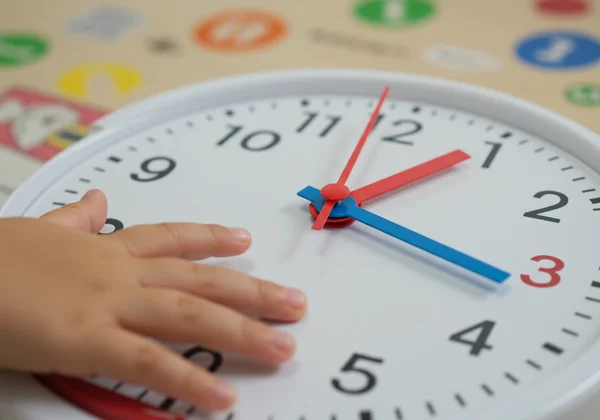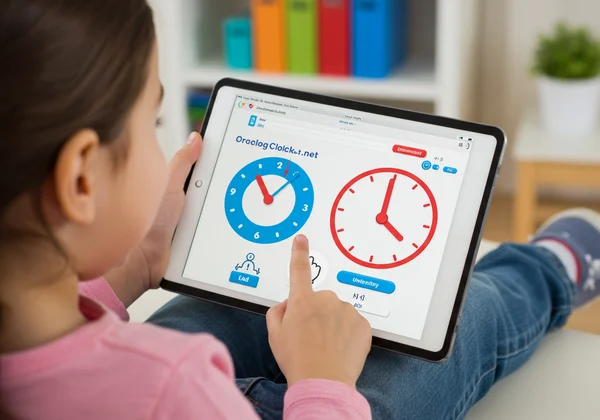Why Learning Analog Clock Time is Hard for Kids: Brain & Cognitive Skills
Have you ever watched your child stare at an analog clock, a look of pure confusion on their face? You’re not alone. For countless parents and teachers, the process of teaching kids to tell time feels like an uphill battle. It's a common struggle, and many wonder, why is telling time hard for them? The answer isn't about intelligence or willingness to learn; it's rooted in the fascinating way a child's brain develops.
This guide explores the cognitive reasons behind the challenge and offers strategies to make learning feel like play. By understanding the hurdles, you can transform frustration into a fun and rewarding journey, especially with a great interactive clock at your side.
Understanding Child Development & Time Concepts
To truly grasp why clock-reading is a puzzle for kids, let's explore how their young minds process the world and build fundamental concepts necessary for understanding time. The difficulty often lies not with the clock itself, but with the abstract nature of time and the cognitive skills for time required to understand it. When we grasp this, we can teach with more empathy and effectiveness.
The Abstract Nature of Time for Young Minds
For young children, the world is concrete and tangible. They can hold a toy, see a tree, and feel the rain. Time, however, is completely abstract. You can't see, touch, or hold "five minutes" or "half-past two." This is the first major hurdle.
A child’s brain develops the ability for abstract thought gradually. Until then, they need to connect invisible concepts to their real-world experiences. Simply telling them a short hand points to the hour is meaningless without connecting it to a concrete event, like "the short hand points to the 3 when your favorite cartoon starts." This is why rote memorization often fails.

Essential Cognitive Skills for Reading a Clock
Reading an analog clock is not one skill but a combination of several complex cognitive functions working together. A child must master these individual pieces before the full picture makes sense.
These essential skills include:
- Number Recognition: Identifying numbers 1 through 12.
- Skip Counting: The ability to count by fives, which is crucial for reading the minutes.
- Spatial Awareness: Understanding directionality and the circular layout of the clock face.
- Symbolic Thinking: Recognizing that the hands are symbols that represent different units of time.
- Dual Processing: Tracking two pieces of information (the hour and the minute) simultaneously.
When you break it down, it's clear that reading a clock is a significant mental workout for a young mind.
Common Hurdles: Specific Challenges in Learning Analog Time
Beyond the developmental stage, the design of the analog clock itself presents several unique challenges. These are the specific sticking points where children often get stuck. By understanding these, you can pinpoint where your child needs extra support and practice.
Distinguishing Between Hour and Minute Hands
To an adult, the size difference between the hour and minute hands is obvious. To a child, it’s subtle and confusing. They have to remember that two pointers, moving at different speeds from the same central point, represent completely different scales of time.
This is a common source of error. Children may mix them up or read the minute hand against the large hour numbers. Clarifying the distinct jobs of the hour and minute hands is a critical first step. Using tools where the hands are different colors, like the blue hour hand and red minute hand on our free learning tool, can make this distinction much clearer.

Mastering Minutes: The Leap to Counting by Fives
This is arguably the biggest leap in logic. A child sees the number "4" on the clock face, but they must translate it to "20 minutes." This requires them to ignore the number they see and instead perform a mental calculation.
This process of counting by fives is not intuitive. It demands a child to override their basic counting instinct and apply a new, more complex rule. It takes a lot of repetition and hands-on practice for this new rule to become automatic and feel natural.
The Circular vs. Linear Reading Challenge
From their first picture book, children are taught to read from left to right in a straight line. An analog clock breaks this rule entirely. It is a circular vs linear reading system where numbers progress in a circle, and the hands move clockwise.
This change in directionality can be disorienting. It forces a child’s brain to adapt to a new way of processing information. They must track movement in a circle, which is a far more complex spatial task than following words on a page. Interactive practice on a telling time practice tool helps them internalize this unique circular movement.

Strategies to Make Time Click: Effective Teaching Methods
Understanding the challenges is the first half of the solution. The second is using effective, fun, and patient teaching strategies. Instead of drills and flashcards, focus on making time a tangible and playful part of your child's world. These methods turn a difficult task into an exciting game.
Making Time Tangible with Concrete Examples
Connect the abstract concept of time to your child's daily routine. This grounds the numbers on the clock in real, meaningful events. Instead of just saying, "It's 7:00," say, "Look, the little hand is on the 7. It's 7 o'clock, time for dinner!"
Use language that describes duration. For example, "We will play at the park for one whole turn of the big hand." These concrete examples build a mental framework that helps children understand what time feels like, making the numbers on the clock more than just symbols.
The Power of Interactive Tools Like AnalogClock.net
Static worksheets can't replicate the dynamic nature of a clock. This is where interactive tools become game-changers. The Analog Clock tool was designed as a fun clock playground to solve these very challenges.
Children can drag the blue hour hand and red minute hand themselves and see the digital time change instantly. This hands-on manipulation builds a deep, intuitive understanding of how the hands work together. Features like the "Random Time" button create fun challenges, while the "Hide Digital Time" option allows for self-testing. This active engagement transforms passive learning into an exciting discovery process, making it one of the best telling time games available.

Patience, Practice, and Play for Lasting Understanding
Finally, remember that learning to tell time is a marathon, not a sprint. Every child learns at their own pace. Frustration will only create negative associations with learning. The key is consistent, low-pressure exposure.
Celebrate small victories, like correctly identifying the hour or counting the minutes on one side of the clock. Keep the mood light and encouraging. Your patience and practice, combined with playful tools, will create a positive environment where true, lasting understanding can flourish.
Empowering Your Child's Time-Telling Journey
The journey to mastering an analog clock is more complex than it appears. It involves significant cognitive leaps, from grasping abstract concepts to mastering new ways of counting and reading. By understanding the developmental hurdles your child faces, you can approach teaching with greater empathy, patience, and success.
Remember, the goal is not to memorize but to understand. Transform practice from a chore into a delightful game. You have the knowledge, and with tools like our interactive clock, you have the perfect partner for this educational adventure.
Ready to start the fun? Visit the fun clock playground today and watch your child’s confidence tick up, one minute at a time!
Your Questions About Kids Learning Time Answered
What age should a child be able to read an analog clock?
Most children are developmentally ready to start learning between the ages of 5 and 7. However, every child is different. Focus on their readiness, such as being able to count to 60 and count by fives, rather than a strict age milestone. The key is gentle introduction and playful practice.
How do you explain the hour and minute hand to a child?
Use simple, memorable language. A great way is to say, "The short hand is the hour hand; it moves slowly because hours are long. The long hand is the minute hand; it moves faster because minutes are short." The best method is visual. On an educational clock with colored hands, you can show them how the red minute hand has to go all the way around for the blue hour hand to move to the next number.
Why are analog clocks still taught in school?
Learning to read an analog clock teaches more than just telling time. It helps develop crucial cognitive skills like spatial reasoning, understanding fractions (quarter past, half past), and grasping the concept of time duration and passage. It provides a visual representation of time that a digital display cannot.
Are analog clocks better for learning time than digital?
For learning the concept of time, yes. An analog clock shows that time is continuous and cyclical. It helps a child visualize how much time is left until an event or how much time has passed. Digital clocks are great for a quick, precise reading, but they don't help a child build a foundational understanding of time's flow.